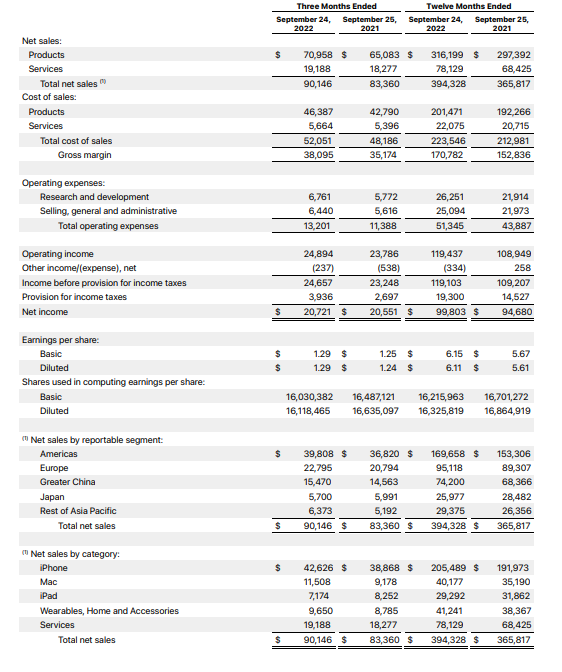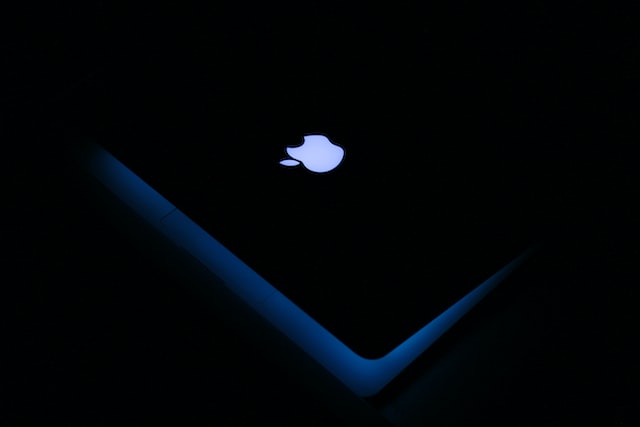Before we dive deep into the Marketing Mix (4Ps), let’s get the business overview of Apple.Apple Inc. is an American multinational technology company that designs, develops, and sells consumer electronics, computer software, and online services. The company was founded in 1976 by Steve Jobs, Steve Wozniak, and Ronald Wayne and is headquartered in Cupertino, California.
Apple is best known for its range of products, including the iPhone, iPad, Mac, Apple Watch, and Apple TV. The company also offers a range of software products, such as the macOS operating system, iTunes, and the Safari web browser. In addition, Apple provides various online services, including the App Store, iCloud, Apple Music, and Apple Pay.
Apple is known for producing high-quality, innovative products focusing on design and user experience. The company has a loyal customer base and is one of the most valuable companies in the world, with a market capitalization of over $2 trillion as of March 2023.
Financial Performance: Apple generated a revenue of $394 billion in FY22 with a net income of $99 billion. (Source)

Here is the Marketing Mix (4Ps) for Apple
A marketing mix, also known as the 4Ps of marketing, is framework marketers use to develop and implement effective marketing strategies. The concept helps businesses identify and optimize the key components necessary to promote and sell their products or services. The 4Ps of the marketing mix are Product, Price, Place, and Promotion.
In addition to the traditional 4 Ps, marketers have expanded their strategies by incorporating additional elements (People, Process & Performance) to help them better understand and reach their target audiences. But we will focus on the 4Ps as they still are the foundation of any marketing strategy. In this article, we will understand the marketing mix (4Ps) of Apple.
What is a Marketing Mix? What are the 4Ps of Marketing?
Product
- iPhone: Apple’s flagship product, the iPhone, is a series of smartphones that combine a mobile phone, camera, and internet device. With its sleek design, intuitive user interface, and cutting-edge technology, the iPhone has become a status symbol and a dominant player in the smartphone market.
- iPad: The iPad is a line of tablet computers that offer a larger display and more computing power than the iPhone. The iPad is famous for entertainment, content consumption, and productivity purposes, catering to both individual consumers and businesses.
- Macintosh (Mac): Apple’s line of personal computers, including desktops (iMac, Mac Mini, Mac Pro) and laptops (MacBook, MacBook Air, MacBook Pro), are known for their high-quality design, performance, and seamless integration with Apple’s ecosystem of software and services.
- Apple Watch: This smartwatch offers fitness tracking, communication, and other functionalities, all seamlessly integrated with other Apple devices. The Apple Watch has gained significant popularity as a wearable device and has contributed to the growth of the wearables market.
- Apple TV: A digital media player and micro-console that allows users to stream content from various sources, such as iTunes, Netflix, and Hulu, onto their television screens. It also supports Apple’s gaming subscription service, Apple Arcade.
- iPod: Although less prominent in recent years, the iPod is a series of portable media players that revolutionized how people consume and manage music.
- Software and Services: Apple has a robust suite of software and services, including iOS, macOS, watchOS, and tvOS operating systems, as well as iCloud, Apple Music, Apple Arcade, Apple Fitness+, Apple Pay, and the App Store.
- Accessories: Apple offers a range of accessories, such as AirPods, HomePod, Apple Pencil, and various cases, adapters, and chargers, which complement its primary products and enhance the user experience.
Price
- Premium Pricing: Apple is known for its premium pricing strategy, meaning its products are generally priced higher than its competitors. This approach is based on the perception of superior quality, design, and user experience that the company’s products offer. The premium pricing not only helps Apple maintain its high-end brand image but also allows it to generate higher profit margins.
- Skimming Strategy: Apple often employs a price skimming strategy, especially during the launch of new products. This involves initially setting a high price for a product when it is first introduced to the market and then gradually lowering the price over time. This approach allows Apple to maximize profits from early adopters who are willing to pay a premium for the latest technology while eventually making the product more accessible to a broader audience as the price decreases.
- Product Line Pricing: Apple uses product line pricing to offer a range of products at different price points, catering to various customer segments and budgets. For example, the iPhone lineup consists of multiple models with different features and prices, such as the iPhone SE (more affordable) and the iPhone Pro models (higher-end). This allows Apple to maintain its premium positioning while offering options for consumers with different budgets and needs.
- Bundle Pricing: Apple sometimes offers bundle pricing, which involves selling a combination of products or services together at a discounted price. This can encourage customers to purchase additional products or services, such as Apple Music, Apple TV+, or iCloud storage, along with their primary Apple device. Bundle pricing can increase customer loyalty and generate additional revenue streams for the company.
- Geographic Pricing: Apple’s prices may vary across countries and regions due to taxes, import duties, and currency fluctuations. The company adjusts its prices accordingly to ensure its products remain competitive and accessible in different markets.
Place
- Apple Stores: Apple operates a global network of retail stores that serve as flagship locations for showcasing and selling its products. These stores are known for their minimalist design, personalized customer service, and interactive product displays. Apple Stores are crucial in enhancing brand awareness, providing a consistent customer experience, and offering services like product repairs and workshops.
- Online Store: Apple’s online store allows customers to purchase products and services directly from the company through its website or mobile app. The online store offers a seamless shopping experience, with options for customization, easy access to product information, and convenient delivery options. It also provides a platform for Apple to launch new products and run promotions.
- Authorized Resellers: Apple partners with authorized resellers and retailers, such as Best Buy, Target, and Amazon, to distribute its products to a broader audience. These partners are carefully selected to ensure they align with Apple’s brand image and customer experience standards.
- Carriers: For products like the iPhone, Apple collaborates with mobile network carriers to offer various plans and promotions, making it easier for customers to purchase devices with contract agreements or installment plans. This helps Apple reach a broader customer base and allows consumers to access its products through convenient payment options.
- Distribution Centers: Apple maintains a network of distribution centers and warehouses worldwide to manage its inventory and ensure efficient delivery of products to retail locations, resellers, and online customers. This global supply chain infrastructure is crucial to meeting customer demand and maintaining a competitive edge in the market.
- Omnichannel Approach: Apple employs an omnichannel strategy to provide customers with a consistent and seamless shopping experience across all online and offline touchpoints. This includes options like in-store pickup for online purchases and integrating the Apple Store app with the retail store experience.
Promotion
- Advertising: Apple is known for its creative and memorable advertising campaigns highlighting its products’ unique features, design, and user experience. These advertisements often focus on simplicity, emotion, and storytelling, effectively connecting with customers and creating a strong brand recall. Apple uses a mix of traditional media (television, print, billboards) and digital media (online ads, social media, video platforms) to reach its target audience.
- Public Relations: Apple’s public relations efforts aim to generate positive media coverage and maintain a favorable brand image. The company often uses product launches, press releases, and exclusive interviews to create buzz and excitement around its products. Apple is also known for its highly anticipated keynote events, unveiling new products and updates, and generating significant media attention and consumer interest.
- Social Media: Apple uses social media platforms like Twitter, Instagram, and YouTube to share product updates, announcements, and promotional content. While the company’s social media presence may not be as extensive as some other brands, it strategically leverages these platforms to engage with customers, showcase its products, and enhance its brand image.
- Influencer Marketing: Apple occasionally partners with influencers, celebrities, and content creators to promote its products and services. These collaborations help the company reach new audiences and create an aspirational image around its offerings.
- Product Placement: Apple strategically places its products in popular movies, TV shows, and music videos, showcasing them in a subtle yet effective manner. This promotion enhances brand visibility and positions Apple products as popular among influential figures and the general public.
- In-Store Promotions: Apple uses in-store promotions, such as product displays, demonstrations, and workshops, to engage with customers and showcase the features and benefits of its products. This hands-on approach allows potential customers to experience Apple products firsthand and facilitates informed purchase decisions.
- Loyalty Programs and Promotions: Apple occasionally offers promotions, discounts, or special offers to incentivize purchases, such as trade-in programs, educational discounts, or seasonal sales. These promotions help drive sales and encourage customer loyalty.











